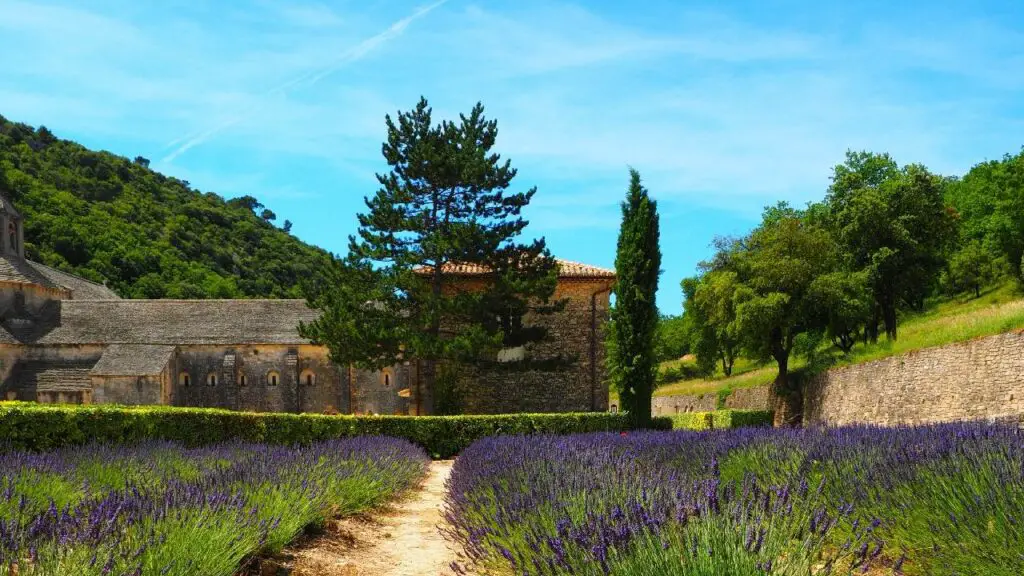Choosing the correct trees for your landscape can be a challenge. This is especially true if you have a tiny yard space to work with because you need to make the most of every foot of gardening area you have. When the space is limited, a tall skinny tree for your landscape will often be perfect solution.
Even if you aren’t short on space, planting multiple tall, skinny trees either evenly spaced alongside a driveway, as privacy screens, or planting just one or two as accent can change the look of your yard. It lends a touch of elegance to the seemingly dull regions of your property.
Choosing a tall, skinny tree for landscaping that won’t occupy much horizontal space is a wonderful way to achieve this. We present excellent trees that will instantly beautify your outdoor space.
Tall Narrow Trees For Your Landscape are often refered to as columnar trees because they grow in a column like fashion. Continue reading to learn more about these remarkable tight-space trees. You’ll know about their benefits, and you’ll get a glimpse into each tall, skinny tree!
Table of Contents
Advantages of Skinny Trees
Tall trees with narrow forms, such as those you’re about to see, are ideal for small landscapes. Because of their compact, skinny growth pattern, they don’t take up a lot of horizontal space while providing the kind of looks that only a tree can provide. Often a tall skinny tree can be planted where no standard tree would fit.
Yes, some of these types grow rather high, but the sky is the limit even in the tiniest areas!
Most of the time, maximizing vertical space is the best option. So, if you’re looking to expand your landscape’s reach and add plants with interesting shapes, tall, narrow trees are the way to go. These trees even give your landscape a strong but still natural vibe.
These thin trees can also help in a variety of different ways in small gardens and yards. Not only do they offer visual interest to tiny gardens, but many of these trees also produce delicious fruits and seeds that birds and other living creatures appreciate.
Some flowering trees produce tiny blossoms that supply nectar and pollen. The pollen gives protein and other nutritional substances, while the nectar offers energy. Bees utilize most pollen as larval food, but they also transport it to another plant, making pollination possible for plants and therefore bettering nature in general.
Ginkgo Biloba
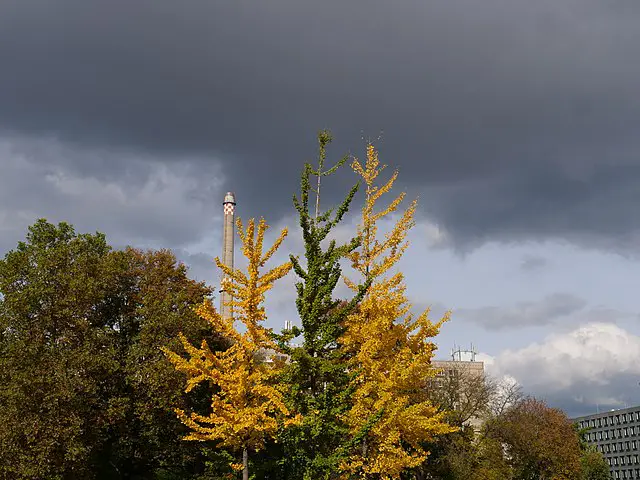
The Columnar Gingko Biloba Tree is a tall and thin tree that can grow up to fifty feet high. Despite it being quite tall, it won’t take up much space in your landscape, for its spread is only ten feet. And when you look at its crown, you’ll love that it has a nice flame shape.
It has distinctive, fan-shaped green leaves that turn a brilliant, golden buttery yellow shade in the fall and a unique winter silhouette that would look eye-catching in even the smallest of yards.
The leaves, unaffected by urban pollution, will help eliminate air pollution, providing you with access to fresh, good-quality air. This slender Gingko will give shade and a lovely deep green theme against which other plants may stand out.
Did you know that Ginkgo biloba, one of the world’s oldest surviving tree species, has a significant history in Chinese medicine? For senility, royal court members were fed ginkgo nuts. Ginkgo has also been used to treat asthma, bronchitis, and renal and bladder problems.
Port-Orford-cedar (Chamaecyparis lawsoniana)
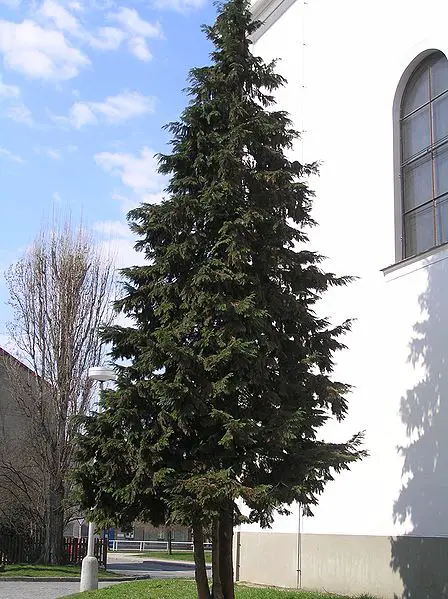
Chamaecyparis lawsoniana is a big evergreen tree that may grow up to 197 feet tall, with trunks 4–7 feet in diameter and feathery leaves in flat sprays that are typically glaucous (blue-green). Its common name is Port-Orford-cedar, and it is a member of the family Cupressaceae.
According to Krusmann’s “Cultivated Conifers,” approximately 300 cultivars have been developed from this species, far more than any other conifer. As cultivators get older, their distinguishing features fade, making them hard to spot.
Chamaecyparis lawsoniana grows best on damp, well-drained soils in a protected spot in a full sun area. Hundreds of cultivars with different crown shapes, growth rates, and leaf colors have been chosen for use in parks and gardens. One such interesting cultivar of this tall, skinny tree is ‘Wissel’s Saguaro.’
Chamaecyparis lawsoniana’ Wissel’s Saguaro’ is a thin tree that is straight out of a Dr. Seuss story! It is a slow-growing tree that you’ve never laid eyes upon before. The cultivar Wissel’s Saguaro’s erect branches resemble those of a saguaro cactus, thus the name. This evergreen faux Cypress grows to a height of approximately 10 feet with a spread of just 6 to 8 feet. It is quite an interesting garden tree, and it thrives in zones 4-9.
Sky Pencil Holly Tree (Ilex crenata’ Sky Pencil’)
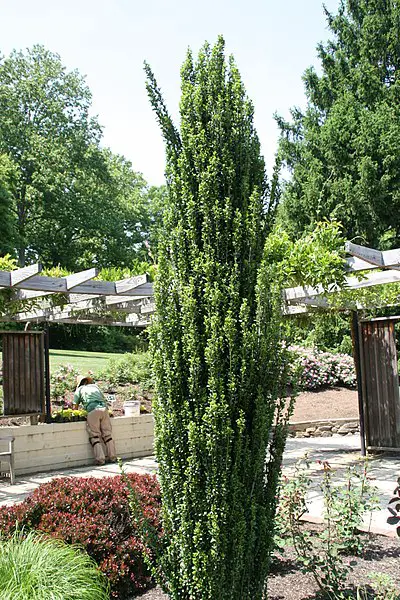
As its name, ” Sky Pencil, ” indicates, this Japanese holly tree has a restrictive, upright, pencil-thin growth habit, as its name, “Sky Pencil,” suggests. This thin, shrub-like, columnar evergreen plant’s modest growth makes it ideal for compact gardens.
The Sky Pencil Holly tree reaches a height of 6 to 10 feet in full sun. And with its fastigiate, vertically growing branches and smooth leaves, it’s sure to be an exciting piece in your landscape. Even more so when a pollinating male plant of this species is present, for when that happens, the females produce small purple berries.
Late in the summer, this tall, thin tree blooms with tiny white flowers. The ‘Sky Pencil’ trees are ideal for creating a narrow hedge or screen (when planted in a row). Columnar plants such as the Sky Pencil Holly tree are great for highlighting borders, container gardening, and growing along roads and walkways. It will live perfectly fine in zones 6 to 8. This plant is an appropriate distinct vertical accent for your landscape.
Red Maple ‘Walters Columnar’ (Acer rubrum ‘Walters Columnar’)

One of the most ubiquitous trees in eastern North America is the red maple.
The most notable characteristic of red maple is its spectacular fall coloration. Its brilliant red leaves stand out against the dark green conifers and the yellow foliage and white bark of the paper birch trees in the northern woodland. The red maple is a popular landscaping tree.
Scarlet maple, soft maple, swamp maple, Drummond red maple, Carolina red maple, and water maple are all names for red maple (Acer rubrum).
The ‘Walters Columnar’ cultivar is an excellent option if you want a tall, erect, columnar red maple tree. This fastigiate tree, sometimes known as scarlet maple, grows vertical, tall, and relatively thin. This maple tree produces beautiful red blossoms in the spring, and the rich green foliage becomes a stunning, intense red hue in the fall.
Columnar red maples are great trees for creating a strong vertical accent on your property. You may also make a screening hedge by planting trees together. Pruning is essential to keep the columnar maple under control because it can grow to be 60 feet tall. Zones 3 to 9 are where red maples thrive.
Some notable columnar red maple cultivars include the fastigiate ‘Scarlet Sentinel,’ the slender upright ‘Columnare,’ and the silvery bark and red fall leaves of the ‘Armstrong’ columnar maple tree.
Swedish Columnar Aspen (Populus tremula ‘Erecta’)
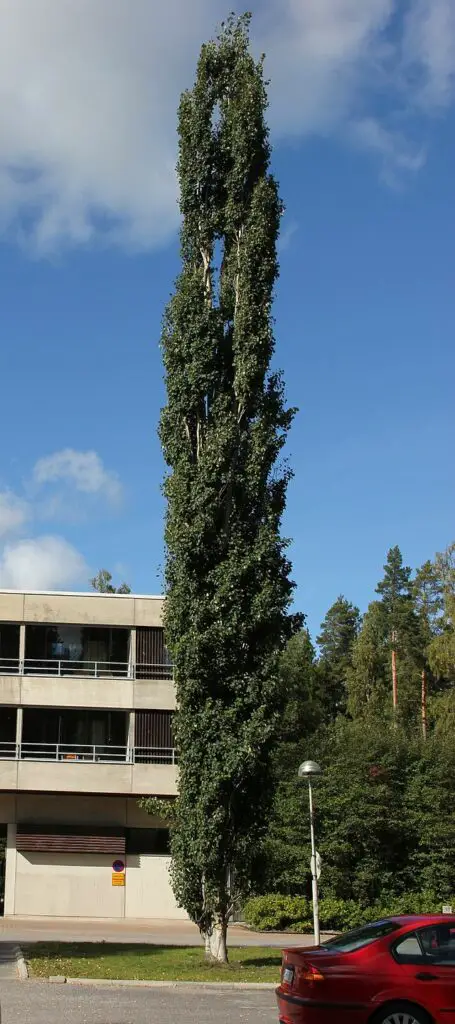
The Swedish Columnar Aspen’ Erecta,’ also called Upright European Aspen, is a beautiful columnar tree because of its pole-like growth. When grown as a specimen tree, its tall, thin form provides an appealing visual height.
This tall, slender aspen tree can grow up to 40 feet tall. This pillar tree’s narrow spread—as little as 10 inches across—allows it to be grown in smaller spaces. Its growth habit resembles that of a candle flame.
In the fall, the emerald green leaves become a lovely golden yellow. These thin trees can also be planted in a row to make high, decorative screens. They can also work as a windbreak!
Lombardy Poplar (Populus nigra)
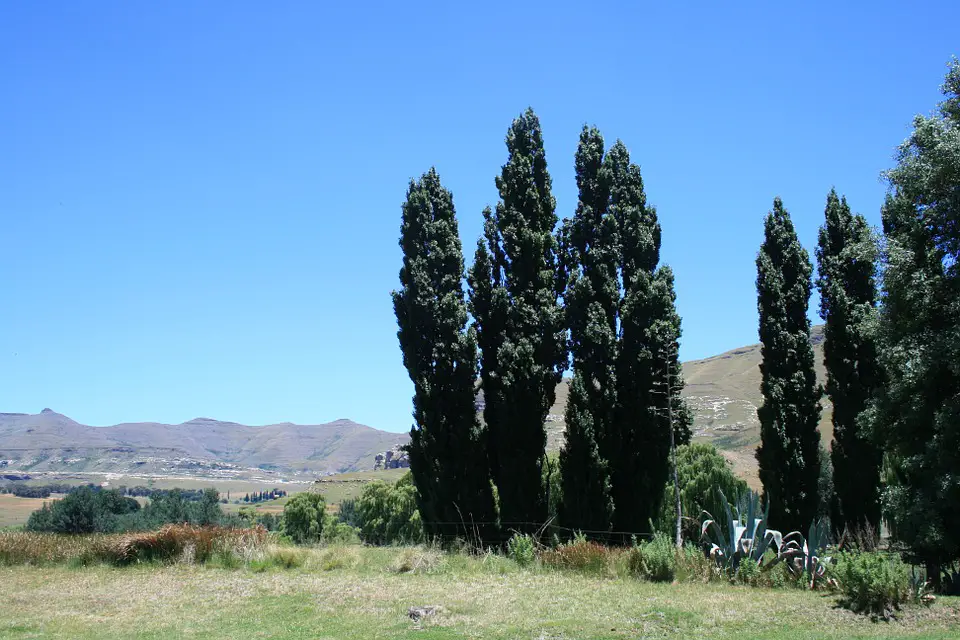
Numerous poplar cultivars are fastigiate trees, with branches that grow almost parallel to the trunk. The Lombardy poplar is one such deciduous tree that grows quickly in warmer regions, with annual growth rates of around 3 feet. These magnificent, upright trees may reach a height of 50 feet and live for 20 years.
You’ll love poplar trees for their thin, cylindrical flowers, too, which are called catkins.
Lombardy poplar trees provide great windbreaks, screens, and driveway ornaments. They thrive in zones 3 to 9 and require full sunlight to thrive.
Because its natural environment is steadily being whittled down by anthropogenic activity and readily hybridizes with other species (especially P. x canadensis), P. nigra can be considered at risk of extinction. That holds true in a significant portion of its native range, particularly in the west and central Europe.
Columnar Arborvitae (Thuja) Trees
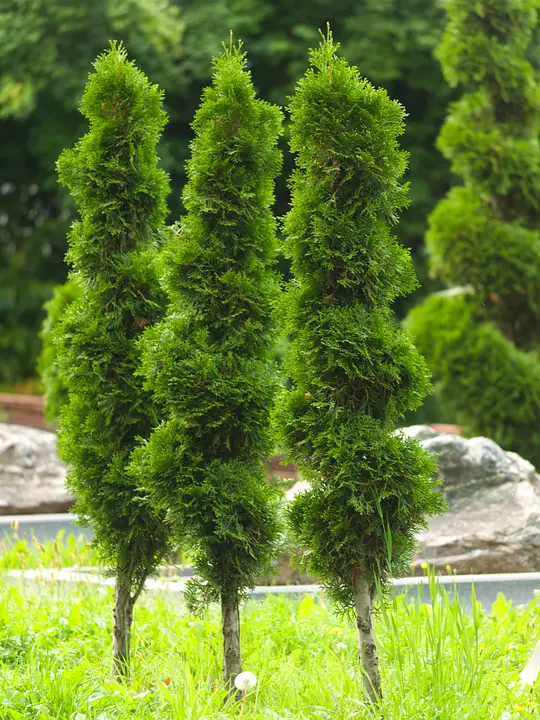
Thuja is a genus of coniferous trees belonging to the Cupressaceae family (Cypress). The genus has five species, two of which are endemic to North America and three of which are native to East Asia.
Arborvitaes are excellent if you’re searching for a quickly growing, low-maintenance evergreen tree to use as a hedge or privacy screen. Plant many of them in a row, and the thick, heavy foliage will fill in in a year or two, making the perfect natural fence.
However, don’t ignore the numerous ways arborvitaes may be used in formal and casual landscape designs.
You can know an arborvitae’s mature size by knowing the species and cultivar. Low-growing shrubs are those that grow to be less than three feet tall, and massive trees can grow to be 70 feet tall and 25 feet wide. Meanwhile, the tree’s shape (conical, mounded, rounded, pyramidal, or pendulous) depends on the cultivar.
As for the foliage, the flattened, lacy fragrant needles of most arborvitaes range in color from emerald green to gold. Early in the summer, clusters of rosebud-like cones measuring approximately half an inch long emerge, changing from green to brown.
Again, there is a wide range of zones where you can find arborvitae trees. It depends on the variety, but it thrives within zones 2 to 8.
Columnar White Spruce (Picea glauca ‘Pendula’)
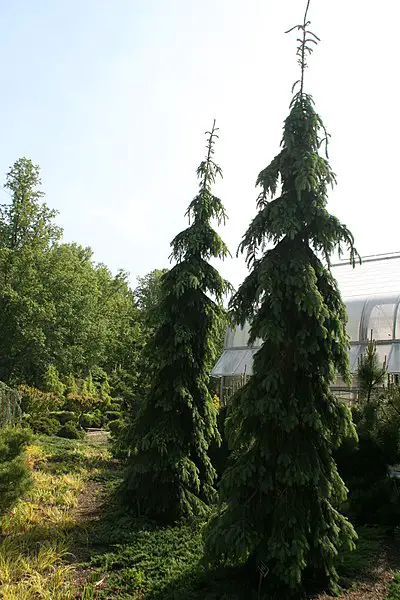
The columnar white spruce, or weeping white spruce, is an outstanding tall, thin evergreen tree. The slim, quickly growing spruce tree has pendulous hanging branches that give it the appearance of a pole. This cascading white spruce grows anywhere between 12 and 40 feet tall in full daylight.
The downside is that the Columnar White Spruce is only hardy in Zone 2 – 7. This plant thrives in rich, damp environments with acidic soil.
This specimen evergreen tree will give the perfect vertical highlight in a compact yard.
Tsukasa Silhouette Japanese Maple (Acer palmatum ‘Tsukasa Silhouette’)

Acer palmatum is a woody plant native to Japan, China, Korea, eastern Mongolia, and southeast Russia.
The popular Japanese Maple tree ‘Tsukasa Silhouette’ (Acer palmatum ‘Tsukasa Silhouette’) is the first columnar variety of the Japanese maple tree. You’ll like to use this 15-20 feet tall, skinny tree as an excellent decorative hedge or a lovely garden focal feature. The foliage is bright lime green in the spring, which changes to deeper green in the summer and a beautiful red shade in the fall.
Many Acer palmatum variants will grow successfully in containers, and almost all of them can sit nicely with your companion plants. And because the trees’ root systems are small and non-invasive, they’re ideal for borders and decorative pathways.
It likes being in part sun, and the recommended zones are 5-9.
Japanese Flagpole Flowering Cherry Tree (Prunus’ Amanogawa’)
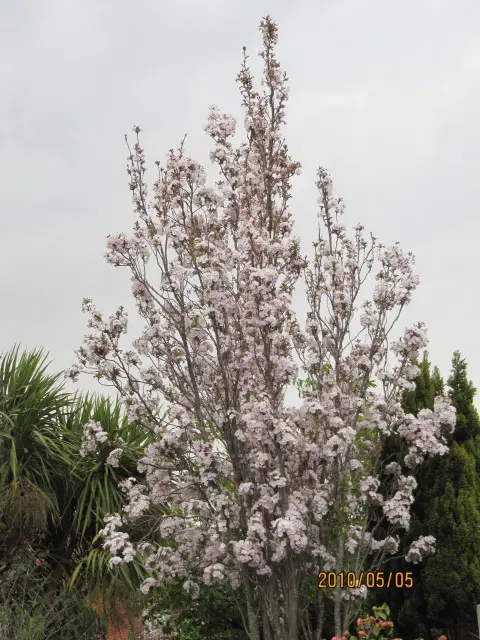
Prunus ‘Amanogawa’ is a tiny, narrowly columnar deciduous tree with abundant, semi-double light pink flowers clinging to the upright branches in mid to late spring. This plant, a member of the Rosaceae family, is ideal for relatively small areas.
Cherry blossoms rise erect at the side of the trees, and you’ll notice that they’re sweetly scented. The enormous saucer-shaped blooms, about two inches wide, open from pink buds and have 6-15 petals.
As they grow, they turn nearly white and have a purple-pink heart right before dropping. The leaves start bronze-green, then become semi before becoming orange and red in the fall. It’s a popular tree for small gardens since it’s healthy, resilient, and easy to grow.
Prunus’ Amanogawa’ is the perfect skinny tree if you want a specimen plant to stand out in your landscape. Of course, you can also plant several of these where you wish to have colorful flower borders.
This plant likes full sun, and they grow best in well-drained, fertile, slightly damp soils.
Italian Cypress (Cupressus sempervirens)
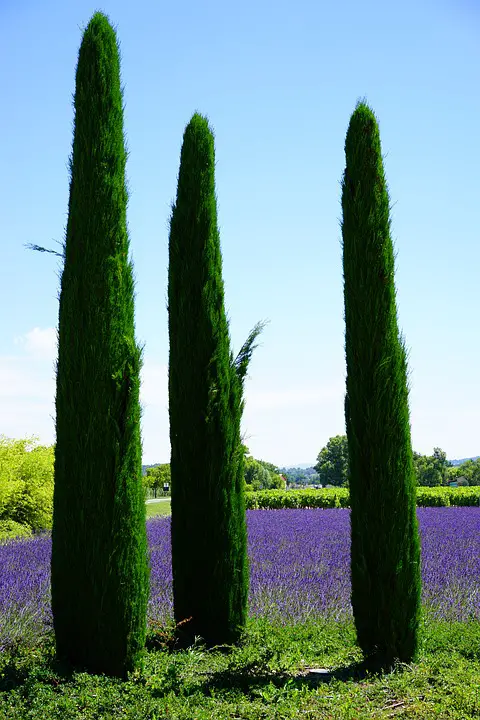
First, it’s nice to have some background on the Italian Cypress’s scientific name, Cupressus sempervirens:
The most well-known tale that explains the link of the Cypress with sadness is written by the poet Ovid, who authored during Augustus’ reign.
Apollo’s favorite, the most handsome young man Cyparissus, unintentionally murdered a cherished tame stag. His remorse and sadness were so unbearable that he begged to be allowed to weep eternally. He was then transfigured as Cupressus sempervirens, with the tree sap acting as his tears.
The classic, interesting story certainly adds a magical element to this beautiful tree. When you have guests over, consider striking up a conversation about the Italian Cypress! A little mythology is nice here and there. To learn about the scientific facts about this tall tree, keep reading.
Italian Cypress is a tall, thin, evergreen conifer with rich dark green foliage that grows quickly. It’s often known as the pencil pine because of its tall, narrow shape that resembles a massive column that converges to a point.
Fastigiate species of this tree have upright and vertical branches that form close to the trunk. Italian cypress trees make a striking impression wherever they grow because of their unusually tall, slender look.
Typical cypress trees can reach 115 feet, while some dwarf varieties only grow up to nine feet tall (and 1-2 feet wide). You can still have an Italian Cypress tree if you have a small space, and it will instantly elevate the look of your landscape!
But wait, there’s one last fun fact about the Italian Cypress:
In July 2012, a five-day forest fire in Andilla, Valencia, destroyed 20,000 hectares of woodland. But, a big, dense group of 946 cypress trees (22 years old) was found almost undamaged within the scorched scene, and just 12 cypresses were wrecked. The CypFire European Project, which researches many characteristics of cypresses (droughts, frosts, production of wood and pollen), planted the Andilla cypresses.
Slender Silhouette Columnar Sweetgum (Liquidambar styraciflua ‘Slender Silhouette’)
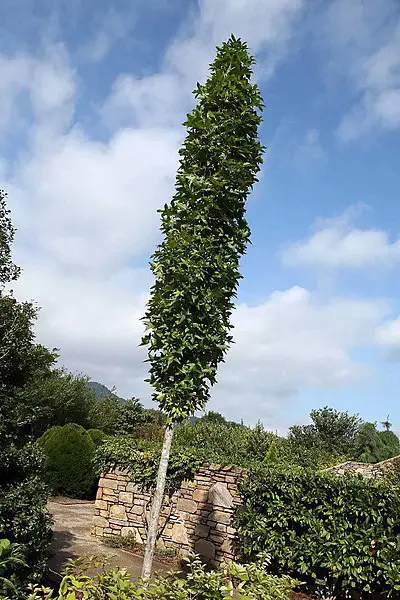
As its name implies, the narrow silhouette sweetgum is a tall and skinny tree belonging to the Liquidambar genus.
The top of the columnar sweetgum tree is roughly the same size as its base. The tall, thin tree resembles a bushy utility pole with its star-shaped glossy green leaves. These trees may reach a height of 50 feet and a spread of only five feet.
Due to their slender profile, Sweetgum trees are ideal for small and medium-sized yards that require a strong vertical focus.
Slender Silhouette is sometimes described as a plant variety that doesn’t bear fruit, although this is likely pure speculation than fact. The tree will yield fruit, but the output of gumballs will be more irregular than that of ordinary wild trees.
You may plant these columnar trees in groups in your garden to create a towering privacy screen. Full sun and consistent watering and fertilizing in zones 5 to 9 are ideal for these trees.
Kindred Spirit Oak (Quercus x warei ‘Nadler’)
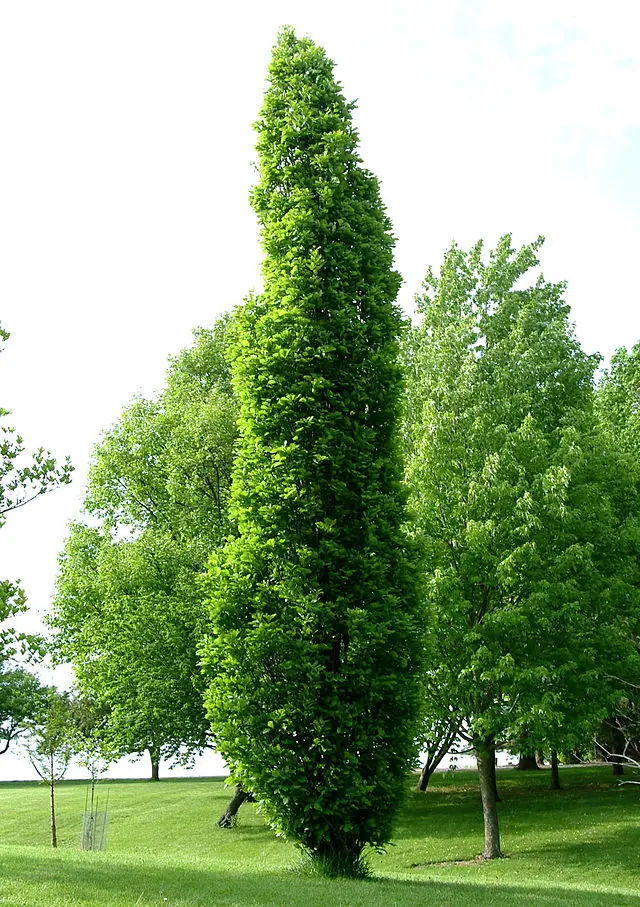
The ‘Kindred Spirit’ cultivar is another magnificent example of a compact columnar oak tree. This tall, vertical tree’s fastigiate narrow growth makes it ideal for small areas.
Meanwhile, the glossy, deep green leaves develop a beautiful crimson hue in the fall, spicing up an autumn garden scene.
The oak tree’ Kindred Spirit’ is more compact than the oak tree ‘Fastigiata.’ This fast-growing deciduous tree usually grows to a height of 30 feet and a width of four feet. Plant a bunch of them in a group to make a tall hedge or plant one as a single specimen.
In zones 4 through 7, you should plant this erect thin tree in full sun.
Despite being a hybrid, it still produces acorns, which offer food for tiny animals. Once developed, it is tolerant to drought and accepts clay soils and salt well.
Skinny, Tall Juniper Cultivars
Junipers come in various sizes and shapes, ranging from 66–131 ft tall trees to columnar or small shrubs with long, hanging branches. These are evergreen and have needle- or scale-like leaves.
Some Juniper cultivars are ideal for landscaping if you’re looking for tall, relatively thin trees. The Blue Arrow Juniper, Skyrocket Juniper, Brodie Eastern Red Cedar, and Pencil Point Juniper are some fantastic options that we will discuss here.
Other much rarer, tall, skinny Juniper cultivars you might consider are the Moonglow Juniper (Juniperus scopulorum ‘Moonglow’), Spartan Juniper (Juniperus chinensis’ Spartan’), and the Blue Heaven Juniper (Juniperus scopulorum ‘Blue Heaven’).
Blue Arrow Juniper
This is an enhanced variety with tight, vivid blue leaves and a very thin, upright shape. A tall, narrow screen made of these trees is ideal when space is at a premium. Thanks to its bright steel blue foliage, it adds a splash of color to the garden. From late spring through late winter, this plant produces silvery blue berries.
The Blue Arrow Juniper is considered the Italian Cypress of colder regions (they both have a distinct columnar shape). This juniper lends a strikingly formal or Mediterranean flavor to landscapes. You can plant this as a hedge for a tall, thin privacy barrier, or these trees can serve as a lovely dark green backdrop for beds and borders. Pair them up to flank a piece of art, a gateway, or a fountain.
This evergreen tree lives in zones 4-9 and likes fully sunny sites.
Skyrocket Juniper (Juniperus scopulorum ‘Skyrocket’)
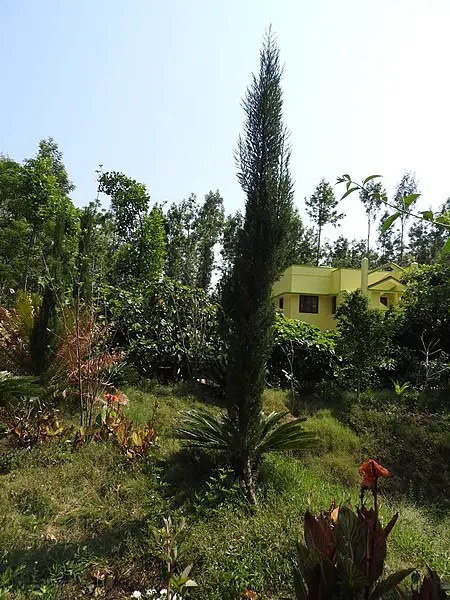
Skyrocket Juniper (Juniperus scopulorum ‘Skyrocket’) is a slender, columnar Juniper that fits into tight spaces like side yards between houses. Planting many ‘Skyrockets’ produces an excellent windbreak in both cold and hot regions. This plant’s vertical shape makes it an excellent accent plant in a mixed conifer landscape.
The fastigiate leaves form an elegant columnar tree with a narrow growth pattern. Meanwhile, its attractive, overlapping, scale-like bluish-green foliage looks nice up close. Indeed, it will pack a punch in your landscape!
It likes to be in full sun and lives in zones 4-9. You can expect it to reach 15 to 20 feet of height but only occupy a span of 2-3 feet.
Finally, you’ll be pleased that there are currently no reported pest issues for the Skyrocket Juniper.
Brodie Eastern Red Cedar (Juniperus virginiana ‘Brodie’)
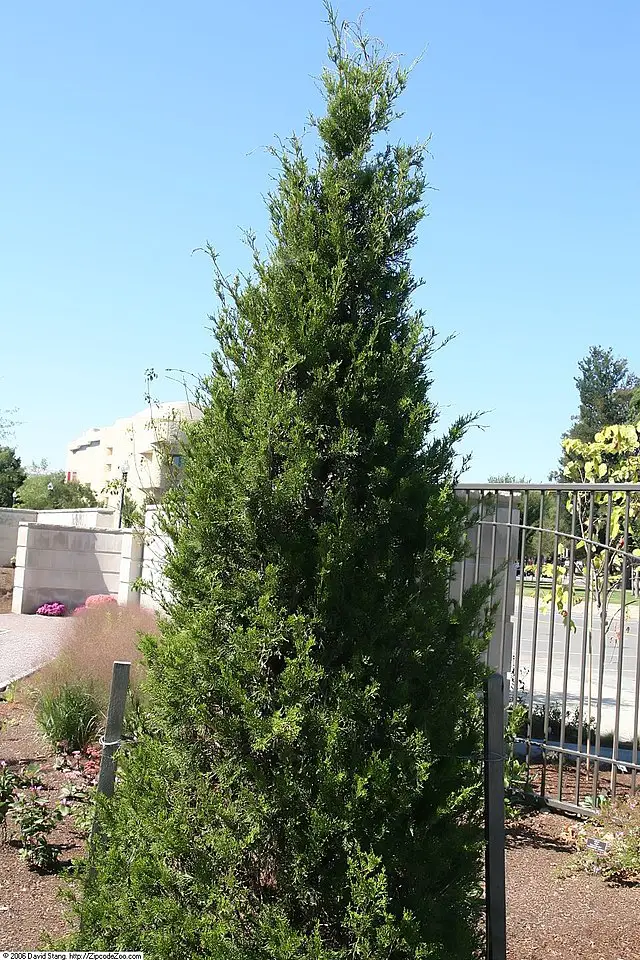
Brodie cedar (also known as Brodie Juniper) is an even tinier, more compact cultivar of juniper that grows as a thin evergreen pyramid. These junipers are sometimes known as pencil junipers because of their tall, skinny genetic structure.
These slender columnar conifers thrive in a wide range of environments. They are drought-resistant, non-invasive plants that grow up to 25 feet tall in bright sunlight.
To make a privacy screen, arrange several Eastern red cedars close to each other.
Pencil Point Juniper (Juniperus communis ‘Compressa’)

Pencil Point Juniper, or Noah’s Ark juniper, is a relatively shorter tree on this list. But it is a slender evergreen with lovely blue-green leaves that will sparkle in the sun. Pencil Point Juniper is an excellent choice for narrow gardens with limited space, reaching a height of six feet and a width of one foot.
Pencil Point juniper likes to be in well-drained soil and forms a good screen or small hedge. Even though it’s not the tallest, this evergreen is a durable, drought-tolerant, and cold-hardy choice for even the most challenging environments. You can have this in your landscape as long as you’re in zones 3-8.
Conclusion
All in all, this selection of tall, skinny trees for landscaping should convince you to get one (or more, or all of them)! They will undoubtedly add dramatic aesthetic appeal to your garden or yard due to their upright, narrow form.
Not only that, these columnar trees, with their dense foliage, can make excellent privacy screens and windbreaks. Even just planting one on each side of a porch can instantly level up the look of the vicinity.
REFERENCES
https://www.nccih.nih.gov/health/ginkgo
https://www.fs.fed.us/database/feis/plants/tree/chalaw/all.html
https://landscapeplants.oregonstate.edu/plants/chamaecyparis-lawsoniana
www.pnwplants.wsu.edu/PlantDisplay.aspx?PlantID=717
https://www.uaex.edu/yard-garden/resource-library/plant-week/holly-skypencil-6-4-10.aspx
https://www.fs.usda.gov/treesearch/pubs/13731
https://www.srs.fs.usda.gov/pubs/misc/ag_654/volume_2/acer/rubrum.htm
https://searchworks.stanford.edu/view/1235642
https://landscapeplants.oregonstate.edu/plants/populus-tremula-erecta
www.pnwplants.wsu.edu/PlantDisplay.aspx?PlantID=434
https://www.cabi.org/isc/datasheet/43535#tosummaryOfInvasiveness
www.conifers.org/cu/Thuja.php
https://web.archive.org/web/20071029202830/http://www.hort.uconn.edu/plants/t/thupli/thupli1.html
https://landscapeplants.oregonstate.edu/plants/picea-glauca-pendula
www.pnwplants.wsu.edu/PlantDisplay.aspx?PlantID=150
https://npgsweb.ars-grin.gov/gringlobal/taxon/taxonomydetail?id=1187
https://edis.ifas.ufl.edu/publication/ST023
https://www.rhs.org.uk/plants/95518/Prunus-Amanogawa/Details
https://ovid.lib.virginia.edu/trans/Metamorph10.htm
https://english.elpais.com/elpais/2012/08/14/inenglish/1344943477_469339.html
https://plants.ces.ncsu.edu/plants/quercus-x-nadler-kindred-spirit/
pnwplants.wsu.edu/PlantDisplay.aspx?PlantID=450
https://www.rhs.org.uk/Plants/57480/Juniperus-scopulorum-Blue-Arrow/Details
www.pnwplants.wsu.edu/PlantDisplay.aspx?PlantID=503
https://edis.ifas.ufl.edu/publication/ST327
https://plants.ces.ncsu.edu/plants/juniperus-communis-compressa/

